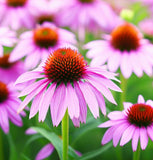Purple Coneflower (Echinacea purpurea)
Purple Coneflower (Echinacea purpurea) is a perennial flowering plant native to eastern and central North America. It is a member of the daisy family (Asteraceae) and is well-known for its striking purple flowers and its traditional medicinal uses.
Appearance: Purple Coneflower is a robust plant that typically grows to a height of 2 to 5 feet (0.6 to 1.5 meters). It has sturdy, hairy stems that bear large, daisy-like flowers with a cone-shaped center (hence the name "Coneflower"). The flowers have vibrant purple petals and a spiky, bronze-colored center. The leaves are long, narrow, and toothed.
Cultivation: Purple Coneflower is relatively easy to grow and is a popular choice for gardeners and landscapers. It thrives in well-drained soil and prefers full sun to partial shade. The plant is drought-tolerant once established but benefits from regular watering, particularly during dry spells. Purple Coneflower is a perennial, and its roots develop a deep taproot, allowing it to withstand harsh conditions.
Medicinal uses: Purple Coneflower has a long history of use in traditional Native American medicine, particularly among the Plains tribes. It was used to treat various ailments, including infections, wounds, and respiratory issues. Today, it is widely used as a herbal remedy and is believed to have immune-boosting and anti-inflammatory properties. Echinacea supplements, derived from the roots, leaves, or flowers of the plant, are commonly used to support immune health.
Wildlife attraction: Purple Coneflower is highly attractive to bees, butterflies, and other pollinators. The flower's central cone, which contains the nectar, serves as a food source for insects. Additionally, birds are known to feed on the seeds of the plant. As a result, Purple Coneflower is often planted in gardens and natural areas to support pollinators and wildlife.
It's important to note that while Purple Coneflower is generally considered safe, some individuals may experience allergic reactions. If you have known allergies to plants in the Asteraceae family, such as ragweed or daisies, it's advisable to exercise caution when handling or consuming Purple Coneflower.
Overall, Purple Coneflower is a visually striking and ecologically valuable plant that offers both aesthetic appeal and potential medicinal benefits. Whether grown in gardens or appreciated in its natural habitat, it continues to captivate with its beauty and cultural significance.
Botanical name : Echinacea purpurea
Common name : Purple Coneflower
Life cycle : Perennial in Zones 3-8
Days to maturity : 90-120
Light requirement : Full sun
Planting time : Spring/Summer
Sowing method : Direct sow
Planting depth : ¼”
Plant spacing : 12”- 18”
Ships : Year-round
Average seed per ounce : Approx. 6,500




















